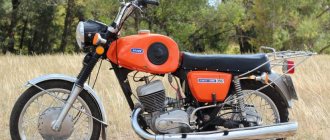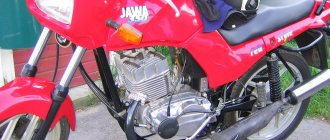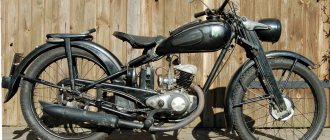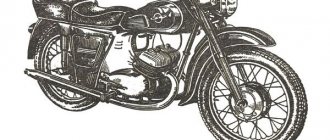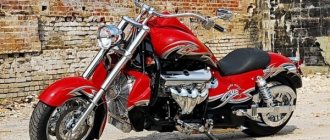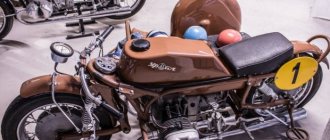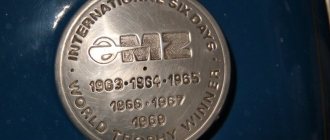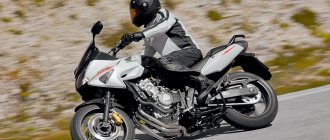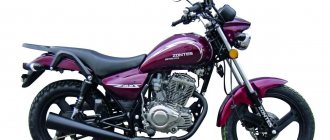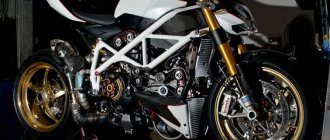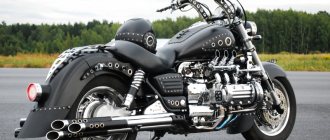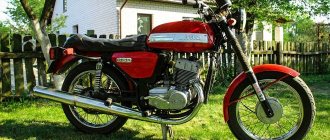In the modern world, Soviet motorcycles occupy an intermediate position between rarities and junk collecting dust in the garage, and the second is often separated from the first only by restoration. Those specimens that are lucky enough to fall into caring hands are carefully restored to a decent condition, but all the rest continue to rot peacefully somewhere in a barn. The least fortunate Soviet motorcycles fall into the hands of novice customizers and turn into “village customs” of varying degrees of horror. Below we will look at the main motorcycle manufacturers of the USSR, not in chronological order, but simply by mentioning the most iconic models. Many Soviet bikes are still alive, decades after their release, because in the USSR motorcycles were designed by engineers, not marketers, and it doesn’t matter what exactly they were - light mopeds or the most powerful representatives of the Soviet motorcycle industry. The first Soviet motorcycle, the Soyuz, assembled in 1924, laid the foundation for the future development of the industry and became a guide for the next several generations of designers.
IZ Planet Sport. The fastest and most technologically advanced.
In 1973, the Izhevsk Motorcycle Plant surprised the whole country by showing the first Soviet motorcycle with a sports bent, the Planet Sport. Unlike all earlier motorcycles, which were created in the image of German models, Planet Sport clearly tried to be similar to Japanese motorcycles of the 60s and 70s.
Due to the high quality of workmanship, IZH Planet Sport was actively sold in export markets, for example, in the UK, the Netherlands and Finland. Soviet bikers accelerated on them up to 140 km/h, which was an incredible speed in those days.
Belarusian “masterpiece” – Minsk 125 Sport
The global market for sports motorcycles is simply huge and we are accustomed to the fact that only foreign companies “rule the show” on it. But, absolutely and undeservedly, we have forgotten about our domestic producers. In this article I will talk about one of the models of domestic sports motorcycles, namely the Minsk 125 Sport motorcycle. This motorcycle simply amazes with its bold, advanced and very beautiful design and, at first, it seems that this is not our “masterpiece” , and some leading foreign one - this is our car, and this is evidenced by the proud inscription on the fairing - “Minsk”. Its appearance became possible thanks to the very close cooperation of our Minsk bicycle and motorcycle plant and the very famous British company MEGELLI, which is widely known today in Belarus. By and large, the Minsk 125 Sport motorcycle is a British sportbike Megelli 125 R, released in 2007.
Sunrise. The most rustic.
Voskhod motorcycles began to be produced in the city of Kovrov, Vladimir region, in 1957.
These were very unpretentious single-cylinder motorcycles (173.7 cm3 engine). The Dyagterev plant constantly improved this model, releasing onto the market after the Voskhod its modernized versions, Voskhod-2, Voskhod-3, Voskhod-3M. The latest Voskhod motorcycle was the 3M-01 model with a 15 hp engine. Because of their reliability, Voskhod motorcycles became real workers in thousands of Soviet villages. Even now you can easily find a Voskhod motorcycle in good condition there.
"Riga-13"
Riga began producing mopeds back in 1958. And since then, many boys have dreamed of their parents giving them a moped for their birthday. This is what they did, so mopeds, and especially the Riga-13, became the first vehicle for many. "Riga-13" began to be produced in 1983. Equipped with a 1.3 hp engine, it accelerated to only 40 km/h. To start from a standstill and move uphill, the “biker” was recommended to help the engine by turning the pedals. "Riga-13" was produced until 1998, becoming the most popular model of the plant.
M-62. Choice of police.
The Soviet police, fair and incorruptible, in the 50s-60s mostly traveled on motorcycles with sidecars.
The M-62, produced by the Irbit Motorcycle Plant, was the most popular choice of servants of the law. Its four-stroke engine produced 28 hp. An interesting fact is that ordinary citizens of the USSR were not allowed to operate Urals without a sidecar at that time.
Still, these motorcycles were quite difficult to control. But the police used motorcycles without sidecars, which looked very cool in the eyes of Soviet boys. How can you not want to become a policeman!
"Dnieper"
The Kiev Motorcycle Plant was founded in 1945 and to date has not been nominally liquidated, although production was stopped several years ago. The first model was the K-1B “Kievlyanin” light motorcycle. At the end of the 1950s, the plant also tried to produce cars, but not for long. And in the picture is the M-72 motorcycle, which was produced by the Kyiv plant according to Irbit documentation from 1950 to 1953. At that time, the plant had not yet used its own name “Dnepr” for its models.
M-1A "Moscow"
Let's try to build this excursion into the motorcycle past of a great country in chronological order. Let's take the post-war period, well, simply because it is clearer and closer to us.
The motorcycle industry was revived on the basis of the best examples of captured equipment. And a lot of it was brought to the USSR. And now at the Moscow Bicycle Plant they are mastering the production of a copy of the German motorcycle DKW RT125 with a 125 cc engine.
The device is called M-1A “Moscow”. This is the first post-war motorcycle of the USSR - simple and lightweight, which did not require a lot of metal and rubber.
Motorcyclists were trained on this type of equipment in DOSAAF schools. In 1951, production was transferred to Minsk to a newly built bicycle plant. Almost the same model with the index K-125 was produced in Kovrov.
Minsk
Some USSR motorcycle models were produced at MMVZ, a plant located in Minsk, the capital of the modern Republic of Belarus. “Minski” were cheaper than the products of the Degtyarev plant, and were also very popular. Motorcycle tourists rode them all over the Union, and this technology was very good for its time. However, later the plant still stopped producing its own bikes, completely switching to assembling new models from Chinese components, which are now sold throughout Russia. But the old 125 cc Minsk still often comes up in the memory of old-school bikers if you ask them a question about the best Soviet motorcycle.
"Izh-49"
In 1951, production of the Izh-49 model was launched in Izhevsk. As in the case of “Moskva,” they took a captured vehicle as a basis. True, the DKW NZ 350 has undergone some improvements, which only made it better - under our brand, of course.
The motorcycle turned out to be reliable, very durable and incredibly beautiful. Even today it is able to captivate a true biker with its appearance - what a fit, what precise lines... Yes, it was a car!
The plant produced versions with a sidecar, sports versions for cross-country and road racing. Not everyone can afford to own them now: the Izh-49 has collector’s value. You can buy it for no less than 100 thousand rubles. At the same time, the price tends to rise.
Imported equipment
Czech motorcycles in the Soviet Union were considered top technology, accessible only to the lucky few. While it was still possible to buy ordinary Izhi with Voskhod, even if they cost a lot, Java and CZ were incredibly difficult to get. Those who wanted to own them were not stopped even by problems with spare parts, which had to be ordered through special stores, since all imported parts were supplied from Czechoslovakia, which was socialist at that time. Now these brands no longer exist de facto, although Chinese motorcycles under the Jawa brand are sold in some countries. This is not the same at all - the best motorcycles of that era left with the USSR. Nowadays, antique Javas are in demand mainly among enthusiasts who would be happy to include them in their collection of retro equipment. Old USSR motorcycles in good technical condition are not easy to find now, but it is worth it if you are partial to such bikes.
"Izh Planet"
1962 The Izhevsk Motorcycle Plant is starting to assemble a fundamentally new model for itself, “Izh Planet”, which became the ancestor of a whole family that was produced until 2008 (“Izh Planet 7”).
A middle-class motorcycle created on the basis of the Izh-56 was intended for driving on roads with different surfaces. The warranty mileage of the Izh Planeta has increased by 2,000 km compared to its predecessor, and the service life of the cylinder-piston group parts has increased by one and a half times (thanks to the use of a contact-oil air cleaner).
A new gas tank, easily removable seat, and mufflers were installed. Instead of stamped front and rear wings, stamped-welded ones were used.
The Izh Planet was powered by a single-cylinder, two-stroke air-cooled engine. The crankshaft is prefabricated and pressed. Carter is of block type. The crank chamber is located in the front part, and the gearbox is located in the rear part. The crankcase consists of two halves with a connector along the middle longitudinal plane. The foot shift and kickstart pedals are located on the left side of the gearbox housing.
The motorcycle was produced until 1966, a total of 405,303 copies were produced - a fairly decent circulation for those times.
Izh
Many Soviet motocross motorcycles were produced at the Izhevsk plant, and they repeatedly took prizes in various competitions. Although this brand is familiar to the general public thanks to the “Planet” and “Jupiter” lines, since several million copies have been produced over the decades, and not all of them have already turned into a pile of rust. And it was at the Izhevsk plant that the first chopper-style motorcycle was produced - the Junker model. This happened after the collapse of the Union, but nevertheless.
M-72. The most combative
The M-72 was not the first army motorcycle in the USSR. In 1934, the assembly of the first Soviet heavy model PMZ-A-750 began, and in 1939 - the “understudy” of the British BSA and, considered to be the best pre-war motorcycle in the Union, TiZ-AM-600.
However, it was the M-72, the design of which was “spiked” from the German BMW R71 (the Wehrmacht was equipped with them), which came out in the tragic year of 1941, and was produced throughout the war. And then they seriously served the people for civilian purposes - the last copies rolled off the assembly line in 1960. From 1941 to 1945, the M-72 carried soldiers armed with anti-tank missile systems, machine guns or light mortars. From the first post-war years - and long after - these motorcycles became the main police transport. And since 1954, ordinary Soviet citizens could buy them for their needs.
“Descendants” of the M-72 were ordered by Saddam Hussein’s Republican Guard at the beginning of the 2000s. But I didn’t have time to use it, and combat motorcycles “went to the people.” At the request of customers, Iraqi auto repair shops install additional “active and passive protection” on the Urals - armor and a machine gun.
Mopeds and scooters
The list would be incomplete without Soviet mopeds such as “Karpaty” and “Riga”. Their first modifications were equipped with bicycle pedals, and were the most inexpensive form of transport, which was very popular in rural areas. And the Tula plant produced motor scooters “Tula”, “Tourist”, “Tulitsa” and a cargo “Ant” with a luggage platform and wide car wheels at the rear. The latter is generally in demand even now, despite the fact that it was discontinued a long time ago. Mopeds in the USSR became so popular mainly due to their low price and the absence of the need to obtain a driver’s license to drive them. They were usually the first motorcycles in the hands of future bikers, instilling in them a love of two wheels. The Carpathian moped was a dream for many of them, especially since it was already completely legal to ride a moped from the age of 14.
L-300 "Red October". The very first.
The very first serial Soviet motorcycle was the L-300 “Red October”.
At the beginning of 1930, Leningrad designers prepared its drawings, inspired by the most reliable bike of that time - the German DKW Luxus 300. And in the fall of the same year, the first batch of L-300 was ready.
The motorcycle was produced until 1938, and then the no less legendary IZH-8 was created on its basis. This “descendant” of the L-300 even ended up on silver coins... in New Zealand.
By the way, the name IZH-7 was borne by the same L-300s, which were produced in Izhevsk in parallel with the Leningrad enterprise “Red October”.
"Minsk M1A". First Belarusian
To this day, the “Minskachi” remains the most “popular” motorcycle in Belarus. They run along the roads of the entire former Union, and not only. But most of them, of course, are in their homeland.
Minsk motorcycles passed their half-century anniversary a long time ago (the first models already fully deserve the name “vintage”), and very soon, on July 12, they will celebrate their 61st birthday.
The first Belarusian “bike” was the Minsk M1A, which had many “relatives” not only in the USSR, but also abroad. The “ancestor” of the motorcycle was developed in 1939 by the Germans. The DKW RT125 turned out to be so successful that analogues of this motorcycle were produced under different names in 7 countries around the world, including the USA, England and Japan.
By the way, one of the old “Minsk racers” was tested in harsh conditions by one of the hosts of the famous British show Top Gear, Richard Hammond. He drove it from south to north almost all of Vietnam. CV of the charismatic “car maniac”: “This is the AK-47 among motorcycles - reliable, simple, easy to repair. It was made specifically for those countries where there are no roads.”
Jawa 350/638
Jawa 350 - 638 - the last Czech motorcycle sold in the USSR, where it also became popular. Having managed to come out just before perestroika, in 1984, this model often starred in harsh films of the late 1980s and early 1990s.
Externally, the motorcycle was relatively simple, but with a twist. The large headlight with round turn signals protruding from the sides and the dashboard wells located on top looked very harmonious.
The tank was voluminous, but had a neat shape; in the rear there were quite large pads for the driver’s knees. But the most important thing on the tank was the inscription “Jawa”.
The 638 had a double, flat seat divided in the middle by a strap for the passenger to hold onto.
The two-cylinder engine was completely open to view, all its components were clearly visible, although its openness played an important role - the engine was air-cooled.
The advantages of this motorcycle included a stylish look, which Soviet motorcycles were very far from achieving.
"Pannonia"
The Pannonia motorcycle has become another iconic motorcycle among urban youth and motorcycle tourists.
Production of Pannonia began in Budapest in 1954. "Pannonia" became the first new motorcycle of the plant. The motorcycle was equipped with a single-cylinder 250 cc two-stroke engine and a four-speed gearbox. The innovation was a closed chain drive and a duplex frame.
From 1954 to 1975, 286,959 motorcycles were delivered to the USSR. The most popular model was the Pannonia 250 TLF. Weighing 146 kg, the motorcycle produced 18 hp, was not picky about fuel, had an 18-liter tank and reliable electrics. In addition, the plant produced a model with a 350 cc engine and a sidecar.
The beauty and perfection of the lines of the motorcycle still make connoisseurs of rarities look for surviving motorcycles.
In 1968, the plant produced a new motorcycle model, copied from the Yamaha YDS-2, but the USSR decided that the motorcycle was too complex and stopped exporting, after which the plant closed.
Java
Brand of road motorcycles produced in Tinec nad Sazavou (Czechoslovakia). The USSR was the main importer of Java. In total, more than a million motorcycles of various models were delivered to the Soviet Union. In Soviet times, Jawa motorcycles were considered the best available for sale in the USSR.
One of the popular names for the Java 360 model was “Java the old woman” or simply “old woman”. “Old women” with a single-cylinder engine were popularly called “chekushki”, due to their volume of 250 cubic centimeters.
There are several modifications that can be divided into motorcycles with 6V and 12V electrical equipment. The 6V version has a less powerful engine and a weak generator, but, subjectively, motorcycles equipped with 6V equipment are more beautiful. "Jawa" are motorcycles of the same class as the "Jupiter", but more pleasant to use.
The most fashionable model in the USSR was the Java-368, which began to be produced in 1984. "Java" had a two-stroke two-cylinder engine with a volume of 343 cc. and a power of 26 hp, the maximum speed of the motorcycle was 120 km/h.
Jawa 360
Almost the ultimate dream of a Soviet motorized person is the Czech Jawa machine. The friendly country made sure that every third motorcyclist in the USSR rode this beauty - in total, more than a million Java cars of various models and versions were delivered to the country.
Production of a new series of Java motorcycles, models 250–623 and 350–633, distinguished by their original design, began in 1970. The motorcycles had a backbone frame and an engine with a separate lubrication system. In 1973, the Java 350–634 model with a duplex closed frame and a new engine was launched into production. The production of motorcycles with an engine capacity of 250 cm³ has ceased.
After modernization in 1984, the model received the index 638 and, with minor changes, continues to be produced to this day.
Many early examples of the motorcycle are still alive today, especially those with a fiberglass sidecar.
"Chezet"
The history of the legendary “Cezet” goes back to pre-war times, when the Czechoslovak arms factory Ceska Zbrojovka (CZ) decided to start producing motorcycles. In 1936, the plant produced prototypes of the Cheset, on the basis of which motorcycles with engines of 250 and 350 cc were later developed.
In 1960, CZ launched the Cheset motorcycles into mass production. In the USSR, CZ experienced unprecedented success. Along with the Java, this motorcycle was a success among rockers, and the black Cheset became the dream of an entire generation.
The famous cross-country Cezet was born in 1962. The motorcycle was equipped with a 250 cc single-cylinder two-stroke engine. Cheset's finest hour lasted until the end of the 60s. Racers from the USSR, Belgium and the GDR competed on it and won championships.
VKB, TsKEB and VNIIMotoprom
The development of sports motorcycles was carried out not only at Irbit and GMZ, but also in Serpukhov. It was there in 1942 that the Main Defense Committee decided to create the Leading Design Bureau (VKB), the solid basis of which was experienced engineers from Izhevsk. However, in the war and early post-war years, the main task of its employees was to restore “trophy” German motorcycles, retrofit with M-72 sidecars, and even dismantle equipment in Germany, which was later sent to Soviet factories along with documentation for the production of certain DKW motorcycle models.
The resulting documentation became a good help for the design of not one, but a whole series of sports motorcycles in the late 1940s:
- 125-cc single-cylinder S1B,
- 250 cc 2-cylinder S2B,
- 350 cc 2-cylinder S3B.
In 1948, based on a design from BMW, a lightweight motorcycle with a single-cylinder 350 cm3 engine with overhead valves “M-31” was also constructed. The prototypes successfully accelerated to 110 km/h, but, despite their success, they were never put into mass production.
Along with the development of copies of famous German models, Soviet designers, under the auspices of the Central Design and Experimental Bureau (TsKEB), formed in 1946 from the VKB, worked on completely their own designs, however, after joining the FIM in 1956, almost all had to be abandoned - motorcycle regulations Federation prohibited the use of two-stroke engines with a compressor, so TsKEB had to switch to the production of four-stroke engines and machines based on them.
By that time, the Serpukhov plant had already left the bureau, but still continued to produce small series of motorcycles. In particular, the S-360 produced there in 1960 was a real milestone. To produce it, Soviet specialists worked closely with the Czech plant Jawa, which has achieved impressive success in the production of cars for road-circuit motorcycle racing (SHKMG).
"S-360" received a 350 cm3 engine. and a power of 50.5 hp, which allowed it to reach a record 210 km/h. Moreover, it was on this model that Soviet racers achieved their first serious successes at international competitions: in 1961 they brought a bronze medal from Finland.
The 4-cylinder Vostok S-364, developed specifically for ShKMG, is considered to be the peak of the Soviet sports motorcycle industry. The power of its 350 cc engine reached 59 hp, which allowed it to reach a speed of 230 km/h. Already in the debut race, this model showed what it is capable of - our athlete took 3rd place, losing only to two non-production prototypes produced by Honda. A few years later, an even faster model with a 500 cm3 engine and 80 hp was released. - “Vostok S-565”. It could accelerate to 250 km/h.
A few years earlier, TsKEB was reorganized into VNIIMotoprom, which was no longer focused so much on motorcycles as on the production of internal combustion engines for various needs.
However, in 1968, engines were nevertheless developed on it, which were successfully used in another motorsports direction - the creation of cross-country motorcycles. In particular, they were installed on the 125-cc models of Minsk Motorcycle, M-212 and M-213. In general, motocross motorcycles were produced earlier, including at other factories. For example, these include motorcycles such as:
- "IZH-50M"/"IZH-50K" (class 350, 1956),
- "IZH-57M"/"IZH-57K" (class 350, 1957),
- “K-58SK/SM” (125 cm3, 1957),
- "IZH-250" (250 cm3, 1957),
- "K-175" (175 cm3, 1957),
- “K-175SK/SM” (175 cm3, 1958),
- "IZH-60K"/"IZH-60M" (350 cm3, 1960),
- "IZH-61K" (340 cm3, 1961),
- “K-250SK/SM” (250 cm3, 1964),
- “IZH-K11” and “IZH-M11” (350 cm3, 1969) and a number of other models.
Some motorcycles even brought victories to our athletes. For example, the 125 cc M10 brought the Izhevsk plant an FIM gold medal for the fact that its cars were the only ones that were able to overcome the 1967 international six-day race without leaving the race.
"PMZ-A-750"
In 1931, the development of medium and heavy motorcycles for the army and the national economy began. The first was the heavy motorcycle “NATI-A-750”. This car was a mixture of traditions: an American-type power unit was built into the chassis, made in the image of a BMW. “PMZ-A-750” was used not only in the army, NKVD units, but also in the civil service. The design of the motorcycle turned out to be durable, but very capricious. As a joke, the letters PMZ were deciphered as “Try to turn me on.”
Vyatka VP-150. Italian elegance.
The last one in our review is not a motorcycle at all, but a scooter.
The Vyatka VP-150, the prototype of which was the Italian Vespa scooter, is rightfully considered the most elegant two-wheeled vehicle in the USSR. It was a quiet and very comfortable scooter that even women could drive with ease. At the Vyatka base they made a whole range of three-wheeled scooters with various bodies, which were actively used in urban cargo transportation.
"Tula-200"
In 1986 - 1988, a very unusual motorcycle, the Tula-200, was produced in the Soviet Union, which was distinguished by wide off-road wheels. They were needed because the model was intended for hunters and fishermen.
They took the engine from the Tulitsa scooter, boosting it to 13 hp. This made it possible to accelerate to 90 km/h, although for such a device speed was not the main indicator; cross-country ability was much more important.
10,000 -12,000 thousand of these bikes were produced per year. The last one rolled off the plant's assembly line in 1996.
Opposites
The pre-war developments of Soviet designers were revised after a thorough study of captured German motorcycles, on the basis of which the first heavy motorcycles of the Soviet Union were created. The very first sample was an exact copy of the BMW R71, although later modernization of the model began, which took it away from the original concept. The bike did not get the name “Ural” right away; for a long time it was just an abbreviation and a number. For decades, boxer cars were produced only in combination with a sidecar, although single models were also produced in the 90s. Urals can safely be called bikes with an incredibly long history, and they are produced even now. Reliable, stylish and durable, they are in good demand in the USA. However, the old motorcycles of the USSR and modern Urals do not have much in common. In the modern world, motorcycles with sidecars are practically not produced, so Russian motorcycles remain practically the only exception here.
ZID-175 4ShP. The first Soviet ATV.
Surprisingly, in our country, despite the complete absence of roads in some places, ATVs have never been mass produced. Almost the only more or less serial copy was the ZID-175 4ShP, produced at the Dyagterev Plant.
The design was not very successful: weak engine, complex transmission elements. This is probably why such ATVs are not widely used.
ZiD
The Degtyarev plant located in Kovrov has been producing motorcycles for decades. At first it was the “Kovrovtsy”, then they were replaced by the “Voskhod”, which were further developed in the form of the “Owl” and “Courier” motorcycles. 50-cc “Pilot” and “Active” devices were also produced, which differed from mini mopeds like “Karpaty” in the most favorable way. But later the Kovrov plant suffered the same fate as the Minsk plant - it began assembling Chinese motorcycles, actively collaborating with the Lifan company. And over the years of production, the aforementioned “Pilot” received almost cult status, head and shoulders above all mopeds of Soviet times. It was much more technologically advanced, and it looked much more interesting in appearance, which can be clearly seen from the photo. The plant also produced special equipment for Soviet athletes, and some models produced at the ZiD plant may well lay claim to the title of the fastest motorcycle of that era. Its technical characteristics were excellent, but we probably won’t give a detailed description here.
In 1958, the Kharkov bicycle factory began producing the B-901 bicycle specifically for the D-4 engine.
Compared to a regular road machine, this bike had a shock absorber in the front fork and larger tires. Apparently, the B-901 can be considered the first Soviet mass-produced motorbike. Then the production of motorbikes was transferred to the Lvov Metal Plant (since 1960, Lviv Motorcycle Plant - LMZ). In the same year, the plant began producing B-902 motorbikes, which differed from the B-901 mainly in the frame design.
In 1962, the plant’s design bureau created the MV-042 “Lvovyanka” motorbike. It was a fundamentally new model with a special load-bearing all-stamped frame, telescopic front fork and even spring-loaded rear suspension.
In the first batches of the Lvovyanka, the engine was still the same - D-4.
In the process of subsequent modernization of the moped, instead of a rear fork with a central spring, they began to install double shock absorbers in aluminum casings. And, most importantly, the D-4 was replaced by a new engine - the D-5, with the compression ratio increased to 6 units. Engine power increased to 1.2 hp. at 4500 rpm, fuel consumption remained at 1.5 l/100km. The high thermal stress of the D-5 forced the designers to use a new cylinder with developed ribs and a removable head.
The “Lvovyanka” was replaced by the light moped “MV-044”, characterized by a developed hood and angular shapes.
In 1969, they began to produce a new model - “MP-045” with a reinforced frame and a larger gas tank.
The last of the light mopeds produced by the Lviv Motorcycle Plant is “MP-047” “Tisa”. After this model, the plant completely switched to the production of heavy mopeds - “Verkhovyna”, and subsequently “Karpaty”.
It should be noted that rear shock absorbers were installed on all light mopeds of the Lvov plant. Light mopeds from other Soviet factories, as well as most foreign light mopeds of those years, did not have such “luxury”.
Almost simultaneously with the plant in Lvov, the production of light mopeds was launched at the Riga motorcycle plant “Sarkana Zvaigzne” (“Red Star”) and at the Penza Bicycle Plant named after M.V. Frunze.
The running gear of the first light moped, the production of which began in Riga in 1959, was the Riga-16 men's bicycle manufactured here.
The familiar D-4 engine was installed on the bike. (A. Popov, Cooled Star, “Moto”, No. 1, 2012, p. 88). The resulting design was very reminiscent of the B-901 motorbike from the Kharkov bicycle factory.
1915 Harley-Davidson with the first original Harley sidecar. A curious machine - a motorcycle with a sidecar. Few of us rode in a stroller or in the back seat, and even fewer of us drove. But there are a small number of wheelchair enthusiasts who love their three-wheeled vehicles, sometimes called a sidecar or sidecar, and a significant number of companies that try to supply their products to their true connoisseurs. The origins of the sidecar are a matter of debate, but with the advent of the roller chain patent in 1880 and the advent of the popularity of the "safety" bicycle (with two equal-sized wheels driven by a chain at the rear), creative minds developed a very lightweight sidecar so that energetic young cyclists could transport their I'll give it style. When motors began to be installed on bicycles, the idea of carrying a passenger arose. In the Victorian era, you couldn't see a self-respecting woman in the back seat, not to mention the old back seats were terribly uncomfortable. The first mention I found of a motorcycle with sidecar was an 1893 competition set up by a French newspaper that promised a reward to the person who could come up with the best way to carry a passenger in comfort and elegance. Three very different methods were presented: from the front, from the back on a trailer, and from the side in a stroller.
Classic English crew. 1953 Ariel square four with Watsonial Squire sidecar Carrying a passenger in the front was a reverse tricycle, with two wheels and a passenger seat in the front and the driver sitting in the back. Anyone who had the pleasure of being in Saigon in 1960 probably drove one of these things with a sociopathic Viet Cong swashbuckler behind the wheel. The main problem was that the passenger literally “took the blow” in any collision. Rear trailer idea. A raised tongue that extends over the rear wheel and is attached to the motorcycle frame, usually under the seat. This two-wheel trailer could provide quite a lot of space, but the passenger would get all the noise and exhaust fumes, which was not popular among graceful ladies. The third and final option is a sidecar. The very first photo of a motorcycle with a sidecar that I saw was a Thor motorcycle with a sidecar, which the American company included in its catalog. The stroller was very presentable, made of wicker twigs. Which is good because of the light weight.
Five years later, motorcycle manufacturers began offering factory sidecars, and not only cradles, but also cargo bodies for delivery vehicles. A motorcycle and sidecar were cheaper compared to cars, and on bad American roads, stuck in the mud, they were easier to get out.
BMW P75 1943 as an example of a military motorcycle with a sidecar from the Second World War
Sidecar frames were fairly simple, usually tubular steel, with a sidecar or cargo container attached by bolts. In 1913, sidecar designers chose 2, 3, or 4 attachment points for the sidecar to the motorcycle. Two-point fastenings quickly disappeared, probably due to the fact that most strollers fell off on their own at speed. Most strollers did not have suspensions, but leaf springs were starting to appear. In 1913, Earl Johnson of Harlan, Iowa, patented a carriage with a sidecar wheel that could tilt with the motorcycle, anticipating the Flexi-Flyer (sidecar wheel tilts when the cradle is level) and Equa-Lean (the wheel sits in the center of the tilting cradle) designs.
The stroller itself could be single- or double-seater, cargo-carrying, with fire-fighting equipment, or a chimney sweeper. Harley Davidson was ready to tap into the stroller gold market. Their first catalog stroller appeared in 1914 and was actually made by Rogers. In 1915, Harley Davidson began making his own strollers. In 1916, the US Army ordered several Harley sidecars to fight Pancho Villa's troops in the deserts along the Mexican border, and Bill Harley designed a machine gun mount for the sidecar. During World War I, many motorcycles with sidecars were supplied to the Western Front, but they were used more as messengers and for transporting officers than for attacking enemy positions with machine gun fire. After the war, cars became quite inexpensive and there were fewer and fewer strollers. Trade continued to flourish with such firms as the English Watsonian (sold strollers since 1912), the German Steib (started in 1914) and the Australian-American Jim Goodling. They were very active, albeit limited. The Great Depression helped the industry a little because the motorcycle and sidecar were the cheapest means of transportation.
The third wheel is useful on a wet dirt road, Daytona Champion 2+2 sidecar After the Second World War, the American consumer society craved huge cars, and not motorcycles with sidecars. In Europe, low taxation on two- and three-wheelers and low car ownership have seen another flurry of interest in sidecars. However, by the late 1950s, thanks to cheap cars such as the British Ford Popular and the German VW Beetle, small cars again defeated sidecars. The industry collapsed, realizing that from a practical point of view, the motorcycle with sidecar had become useless. The only factories producing them as utilitarian vehicles were in the eastern bloc, such as the Czechoslovak Velorex in collaboration with Java, Ural and Dnepr in the Soviet Union [the author either knows nothing about Izh motorcycles with sidecars from the Vyatka-Polyansky plant, or does not consider them for motorcycles at all] and the Chinese. And Harley, of course, but more for ceremonial use. But enthusiasts breathed life into the legend. Californian Doug Bingham, also known as Mr. Side Strider Inc., began building and selling sidecar motorcycles in 1969. He established an annual wheelchair rally in Griffin Park in Los Angeles for decades before his death in 2016. A half-dozen other American companies, such as Champion and Motorvation, as well as Texas and California (made in Virginia), make strollers, with a long list of options and related products.
No need to be afraid of falling on wet grass in the Urals with a sidecar. In Europe, there is a demand for specialized motorcycles with sidecars with complex suspension systems designed to improve handling, usually of a bulky design. I remember well the day when I was riding in the Alps and far ahead I saw a motorcycle with a sidecar. Just as I was thinking about catching up with him, he probably saw me in the rearview mirror and accelerated, and all I could do was hang on behind him. And only in heavy traffic was I able to catch up with him. It was a BMW K100 with a reclining stroller, with a wife and child in it. Now in this country there is only one company that sells motorcycles with sidecars: Russian Ural. And there are a dozen American companies that manufacture or import strollers, the purchase costs of which can vary greatly.
Ural worker Albert Menzi rides with his sidecar raised with his wife Ruth One final note: although sidecar motorcycles are in the collections of many automobile museums, there is only one museum that I know of that is dedicated only to the history of sidecar motorcycles, the Constantino International Sidecar Motorcycle Museum Frontalini near Cignoli in the Italian province of Marcelata. Check out the site, sidecar.it, and you won't be disappointed - knowledge of Italian will be helpful, although the pictures still need a little explanation.
Attaching the Sidecar If you're thinking about attaching a third wheel to your motorcycle, you'd better learn all about toe-in, camber, the offset of the sidecar wheel relative to the rear wheel of the motorcycle, and many other measurements. It is relatively easy to attach the stroller, but not easy to do it correctly. And if you do it wrong, you'll wonder why the damn thing runs so bad. In this country, the sidecar is attached to the right side of the motorcycle, allowing the driver to look ahead of the truck and see what is happening there. In England and other right-hand drive countries, the stroller is attached to the left. Poor English girl whose boyfriend wants to drive across the continent because now the stroller is on the wrong side, as far as the driver has to lean out to see what's behind the truck.
An equa-lean sidecar on a turn in Death Valley, California, 1983. The natural physics of motorcycle handling, including lean, are canceled out when the sidecar is attached. Unless, of course, you have a reclining stroller, but I don’t think any manufacturers make this system yet. I walked a thousand miles with an equa-lean stroller 20 years ago and loved it. But this is probably because at heart I am more of a motorcyclist than a wheelchair user. Once the third wheel is attached, the lean factor goes away and steering takes place by turning the front wheel. Therefore, a motorcycle with a sidecar handles more like a car than a motorcycle.
Buying or attaching a stroller Think seriously. Driving a motorcycle with a sidecar is completely different than driving alone. In fact, there is probably nothing at all in common. Wheelchair riders are generally warm and friendly, so I would wholeheartedly advise a beginner to try to find an experienced trainer in the area and listen carefully to their advice. The largest gathering of wheelchair users can be found through the American Wheelchair Association, which hosts annual meetings and publishes a bimonthly magazine, Sidecarist. You can contact her at sidecar.com Stay in touch and see if any class of wheelchairs is for sale in your area. I especially emphasize: you must receive the necessary instructions.
BMW with a Steib sidecar However, to the extent possible, I will be very grateful to you if you begin your training without drastic actions and do not overestimate your capabilities. The biggest problem is the “lifting” of the stroller, which can occur when driving in a right turn or curve. Simple physics explains that the sidecar will rise up, and the motorcycle will lean in the opposite direction of where the driver wants to turn. This is fun for an experienced wheelchair user and scary for a beginner and his passengers. In 1997, the USCA Sidecar safety program published a 120-page tome written primarily by wheelchair genius David Hogue called Sidecar Motorcycle Driving, 2nd Edition.
A motorcycle with a sidecar makes going out into nature more enjoyable
original article ridermagazine.com/2011/05/13/a-short-history-of-sidecars/
“Verkhovyna-5” (LMZ-2.153)
It was produced since 1974 and featured a greatly modified appearance.
The moped received a horizontal tank with a capacity of 7 liters, a different trunk, and a new front fork. The Sh-57 engine was installed on the moped. In 1978, they began producing Verkhovyna-6 (LMZ-2.158) with a slightly modified design and a Sh-57 engine, and later a Sh-58 with a kickstarter.
In addition to the base model, production of “Verkhovyna-6-Sport” and “Verkhovyna-6-Tourist” was also launched. “Verkhovyna-6-Sport” was distinguished by a top-mounted muffler, a cross-type steering wheel with a jumper and a sprung front wheel guard. “Verkhovyna-6-Tourist” had a wind deflector and two spacious luggage bags behind the driver’s saddle.
One of the “Verkhovyna-6” became the two-millionth moped (!) of the Lviv Motor Plant. “Verkhovyna-7” (LMZ-2.159) - the last of the “Verkhovyna” - was produced since April 1981. The moped was equipped with a new front fork, new, more powerful lighting equipment and a new trunk.
Verkhovyna-7 was equipped with derated Sh-62(M), and later with V-50. The maximum design speed of the moped was reduced to 40 km/h.
In the spring of 1981, a model no less significant for the history of the Lviv Motor Plant appeared - the Karpaty mokik (LMZ-2.160),
0 and in 1986 the mokik “Karpaty-2” (LMZ-2.161) was released. Both Karpaty mokiks, in the development of which the VNIITE branch in Leningrad took part, were equipped with a Sh-58 or Sh-62 engine with a contactless ignition system.
If we talk about the external differences between the “Verkhovyna-7” and “Karpaty” mopeds, the most obvious is the changed shape of the frame, tank, muffler and side casings in the “Karpaty” mopeds. The developers increased the service life of the new model: the warranty mileage of the Karpaty mokik was 8,000 km (Verkhovyna-7 had 6,000), and the service life before the first overhaul was up to 18,000 km compared to 15,000 km for Verkhovyna. Like “Verkhovyna-6”, the mokick “Karpaty” also had similar modifications - the “Karpaty-Tourist” moped and the “Karpaty-Sport” youth moped. Subsequently, the Karpaty-2-Lux moped was also produced, the distinctive feature of which was direction indicators.
In 1988, the Lviv Motorcycle Plant produced 123 thousand mopeds. Once the production volumes of this plant were twice as large, however, in the second half of the 80s it was necessary to reduce the production of 50 cc cars due to a drop in demand and actively develop new models to attract buyers. A new model LMZ-2.164 was developed. In 1990, the Serpukhov Scientific Research Institute of Motorcycle Engineering designed a new modern model of the D-51 engine with a petal valve at the inlet and an automatic centrifugal clutch, which was supposed to be installed on new models of Lviv mopeds, but the engine did not go into production...
The collapse of a united country led to the death of the Lviv Motor Plant. Now on its territory there is the Inter-Sport sports complex, as well as many small companies that have nothing to do with mopeds. Summing up the Soviet stage of the history of domestic motorcycle construction, it can be noted that in the 60s and 70s, the moped was one of the most accessible vehicles for the country's population. Mopeds were produced in the millions; there was never a shortage of mopeds in the retail chain (maybe with the exception of individual models). Mopeds were also affordable. For example, in 1975, a moped “Riga-7” cost 112 rubles, “Riga-12” - 186 rubles, “Verkhovina-5” - 196 - 198 rubles (depending on the configuration). For comparison, the price of an Electron scooter was 270 rubles, a Minsk-105 motorcycle was 330 rubles, a Voskhod-2 was about 420 rubles, etc. Any worker could purchase two-wheeled motor vehicles, especially mopeds.
It is curious that, having overtaken the companies of Germany and France, which laid the foundation for the mass production of small motor vehicles, by the early 80s of the 20th century we took third place in the world (after Japan and Italy) in the production of mopeds and began to supply them to the foreign market (for example, in Hungary, Poland, Angola, Bangladesh, Cuba and even Italy). (M. Leonov, What should a youth moped be like?, “Technology for Youth”, No. 3, 1983, p. 48).
Zid-50 Pilot
Zid-50 Pilot
– a sports road model designed for business trips, tourist trips and walks. It has high technical parameters, fuel efficiency and comfort. The mokika uses a two-stroke, carburetor engine with a crank-chamber purge and a plate valve at the inlet. The electronic ignition system ensures easy engine starting and uninterrupted spark generation in any range of operation. Hydraulic shock absorbers of the front fork and rear suspension ensure a smooth ride when operating the mokika in any road conditions.
